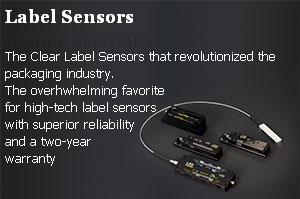| |
上海武田机电,总部设在上海,在香港,德国,美国,日本均设有分公司,拥有良好的购销渠道,欢迎来电咨询 TEL:0086-21-51085793 |
| |
|
|
|
|
| |
    
国际工业装备采购中心
上海武田机电公司,是专业的欧美及日韩进口工业产品提供商。在欧洲,美国,日本及韩国拥有良好的渠道与深厚的关系,代理及经营多种品牌工业产品,欢迎选购。
|
|
|
武田机电


LION标号传感器.
Lion Precision Label Sensors Overview Superior to Optical Sensors (Eyes) Optics-free sensing technology is at the heart of these label sensors. They see labels regular "eyes" can't see — like clear labels on a clear liner! This improved technology also makes them faster and more accurate - even on ordinary paper labels. Our label sensors use capacitive or ultrasonic technology so they have no sensitivity to color or contrast. Changing thickness of the material at the label edge is what triggers the sensors. 2010 Survey Response “We were introduced to Lion years ago, by a label machine manufacturer. The sensors worked better than anything else we had, so we converted all our labelers to Lion.” Lion Precision label sensors are available from distributors all over the world, or you can buy them directly from Lion Precision, or buy them online: Buy Label Sensors online Label Sensor Selection Chart No label sensor can do EVERY label type, but some come close. This selection list will help you choose the right label sensor for your application. The LRD6110 represents the most value because it can do virtually all labels and costs less and is smaller than the UltraLRD V2. Ultra 6110 2100 3100 4100 LionEye 5100 Application Clear Labels ? ? ? ? ? Paper labels ? ? ? ? ? ? Solid foil/metal labels ? ? ? Metallic artwork, printing or stamping ? ? Nonclear Labels Tear-Tape (Clear or colored) ? Splices ? ? ? ? ? Nonclear Labels Rewinders ? ? ? ? Slitters ? Specifications Response Time 500μS 20μS 20μS 20μS 20μS 50μS 20μS Maximum Switching Speed 500Hz 10kHz 10kHz 10kHz 10kHz 500Hz 10kHz Accuracy 0.4mm 0.4mm 0.2mm 0.2mm 0.2mm 0.4mm 0.2mm Features Technology Ultra Sonic Cap. Cap. Cap. Cap. Optical Cap. 10-Segment Bar Graph ? Selectable Light/Dark Switching ? ? ? ? ? ? Separate Sensing Head for Small Spaces ? Vertical/Multiple Sensor Mounting for slitters/rewinders ? Wide Fork (4mm / 0.16") ? NPN and PNP Outputs ? ? ? ? ? ? ? How Clear Label Sensors Work Capacitive Sensing Capacitive sensors use an electric field to sense the amount of material in the sensor. The electric field exists in the gap between a sensing element in the top of the sensor and the grounded baseplate of the sensor. Web material placed in that gap changes the way the electric field behaves — more material changes it more. The electronics in the clear label sensor can sense these changes in the electric field. Differential Capacitive Label Sensing — LRD2100, LRD3100, LRD4100 The LRD2100, the world's first clear label sensor, uses differential sensing. The means there are two sensing elements in the top of the sensor creating electric fields to the baseplate. Then a label is in the sensor, both electric fields behave the same. When a gap enters the sensor, one of the electric fields changes but the other doesn't. The sensor electronics detect this difference and signal the presence of a label to the controller. This type of sensor only sees changes in thickness. For this reason, the sensor rarely needs adjustment because it doesn't care if the label is thick or thin — it only sees the changes. This is an extremely fast and accurate method of detecting label edges. Differential sensors like the LRD2100 have the highest label placement accuracies of any label sensor. Because of the way metallic materials interact with electric fields, if metallic artwork such as a foil logo enters the sensor, the sensor sees many differences between the two sensing elements as the artwork travels through the sensor. For this reason, labels using any metallic materials require a different sensing approach. Single-Ended Capacitive Label Sensing — LRD6110 The LRD6110 has only one sensing element. It measures the absolute thickness of the material in the sensor. This type of sensor is more likely to require an adjustment between different labels in order to set the initial thickness measurement. After that, the sensor triggers the controller when the thickness exceeds a certain point; this point is set to trigger when the additional label thickness is added to the liner thickness. Once the thickness exceeds the trip point, any metallic material is ignored by the sensor because it only makes the label look thicker, but the sensor has already triggered. Ultrasonc Label Sensing — UltraLRD V2 Ultrasonic sensing works much like single-ended capacitive sensing except instead of an electric field, it uses high-frequency sound energy. A transmitting transducer ("speaker") in the base of the sensor transmits sound to a receiving transducer ("microphone") in the top of the sensor. The label web reduces the amount of sound reaching the receiver. The thicker the web, the less sound at the receiver. The sensor electronics measure the sound pressure at the receiver and triggers the control when a label edge is detected. This technology has no sensitivity to metallic materials.
|
|
| |
|
|